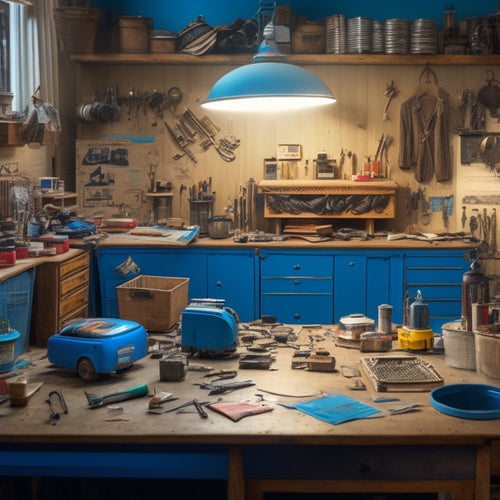Why Thermal Imaging Beats Visual Inspection Alone
Share
When you rely solely on visual inspection, you're likely to miss up to 80% of defects. Thermal imaging, on the other hand, detects defects invisible to the naked eye, uncovers issues missed by visual inspection, and identifies potential issues quickly and accurately. With thermal imaging, you can strengthen quality control processes and shift from reactive to predictive maintenance. In industries with serious consequences for defects, thermal imaging is invaluable. By combining thermal imaging with visual inspection, you'll get a more thorough understanding of your equipment's health, and that's just the beginning of what you'll discover.
Key Takeaways
• Thermal imaging detects defects invisible to the naked eye, uncovering issues missed by visual inspection in industries with serious consequences for defects.
• Accurate temperature measurement matters, and thermal imaging provides reliable data, boosting confidence in predictive maintenance efforts.
• Infrared insights uncover hidden issues, revealing defects not visible to the naked eye, and identifying potential issues before escalation.
• Thermal imaging streamlines the inspection process, quickly scanning large areas and detecting anomalies, reducing time and cost associated with inspections.
• Thermal imaging enables data-driven decision making, capturing and analyzing temperature data, and empowering informed decision-making with improved data quality.
Enhanced Defect Detection Capabilities
When using thermal imaging, you can detect defects that may be invisible to the naked eye, uncovering issues that would have been missed by traditional visual inspection methods. This enhanced detection capability is particularly valuable in industries where defects can have serious consequences, such as in electrical or mechanical systems.
Advanced Scanning technologies enable you to quickly and accurately identify potential issues, allowing for prompt intervention and minimizing downtime. Intelligent Diagnostics further enhance the detection process, providing real-time analysis and alerts for anomalies, ensuring that even subtle changes don't go unnoticed.
With thermal imaging, you can pinpoint defects with precision, reducing the risk of misdiagnosis and ensuring that corrective actions are targeted and effective. By leveraging thermal imaging, you can strengthen your quality control processes, improve overall efficiency, and join the ranks of those who've already upgraded from traditional visual inspection methods.
Accurate Temperature Measurement Matters
You can trust thermal imaging to provide accurate temperature measurements, a critical factor in detecting anomalies and predicting potential failures, as even slight deviations from normal operating temperatures can have far-reaching consequences. Accurate temperature measurement is vital, and thermal imaging delivers.
| Sensor Type | Temperature Range |
|---|---|
| Thermocouple | -200°C to 250°C |
| Infrared | -50°C to 2000°C |
| RTD | -200°C to 500°C |
| Thermistor | -50°C to 300°C |
| Bolometer | -50°C to 500°C |
When selecting a thermal imaging camera, it's crucial to take into account the sensor type and its corresponding temperature range. Calibration importance cannot be overstated, as inaccurate readings can lead to misdiagnosis or delayed detection of issues. Proper calibration ensures that your thermal imaging camera provides reliable data, enabling you to make informed decisions. By choosing the right sensor and calibrating your camera, you can have confidence in the accuracy of your temperature measurements, giving you trust in your predictive maintenance efforts.
Visual Limitations in Inspection
When you're relying on visual inspection, you're often limited by the visibility of the area you're inspecting. You may struggle to see into tight spaces, behind obstacles, or in low-light environments, which can lead to missed defects or hazards.
As you inspect, you'll encounter blind spots that can compromise the accuracy of your results.
Limited Visibility Conditions
In low-light environments, smoke, fog, or heavy particulate matter can severely impede visual inspection, rendering it unreliable or even impossible. You're likely to encounter these conditions in industrial settings, where machinery and equipment can generate significant amounts of smoke or particulate matter. In such scenarios, relying solely on visual inspection can be risky, as you may miss critical issues or overlook potential hazards.
Foggy conditions, in particular, can be challenging for visual inspection. When you're dealing with a foggy environment, it's difficult to distinguish between different objects or detect subtle changes. Low light scenarios are equally problematic, as they can make it hard to identify objects or detect anomalies. In both cases, visual inspection becomes unreliable, and you may struggle to gather accurate data.
Thermal imaging, on the other hand, can overcome these limitations, providing clear and accurate readings even in the most challenging environments. By leveraging thermal imaging technology, you can address the constraints of visual inspection and ensure a more thorough and precise assessment of your equipment and facilities.
Inspection Blind Spots Exist
How do hidden or hard-to-reach areas, such as inner machinery components or elevated structures, escape your visual inspection, leaving potential issues undetected? You might think you're doing a thorough job, but the truth is, human error can creep in, and safety gaps can emerge. It's not uncommon for visual inspections to miss critical problems, especially in complex systems or tight spaces.
Inaccessible areas can harbor hidden dangers, and relying solely on visual inspection can lead to oversight. You may not be able to see corrosion, electrical issues, or heat buildup, but that doesn't mean they're not there. As a result, you might unknowingly put people, equipment, or even entire operations at risk.
Moreover, human error can exacerbate the problem. Fatigue, distraction, or lack of expertise can lead to missed defects or misinterpretation of findings.
This is where thermal imaging comes in – to augment your visual inspection and uncover hidden issues. By combining both methods, you can greatly reduce the risk of human error and safety gaps, ensuring a more detailed and reliable inspection process.
Infrared Insights Uncover Hidden Issues
As you shift from visual inspection to thermal imaging, you'll find that infrared insights can reveal hidden issues that would have gone unnoticed by the human eye.
You'll be able to pinpoint defects that aren't apparent to the naked eye, such as overheating components or electrical anomalies.
Hidden Defects Revealed
Thermal imaging's ability to penetrate surfaces and detect temperature anomalies allows you to uncover hidden defects that would remain invisible to the naked eye. By leveraging this technology, you can identify potential issues before they escalate into costly problems. This is especially important in applications where failure can have severe consequences, such as in industrial equipment or electrical systems.
Some common hidden defects that thermal imaging can reveal include:
- Defect signatures that indicate electrical connections or components are overheating, signaling a potential failure pattern.
- Insulation breaches or gaps that allow heat to escape, reducing system efficiency and increasing energy costs.
- Moisture accumulation or water damage that can lead to electrical shorts or corrosion.
Predictive Maintenance Enabled
By leveraging thermal imaging's ability to uncover hidden defects, you can shift from reactive to predictive maintenance, catching potential issues before they become major problems. This proactive approach enables you to identify and address root causes, reducing downtime and increasing overall efficiency.
| Issue | Thermal Imaging | Visual Inspection |
|---|---|---|
| Motor bearing failure | Detects abnormal heat patterns | Fails to detect until failure |
| Electrical fault | Identifies overheating components | Misses hidden connections |
| Insulation defects | Reveals temperature anomalies | Overlooks hidden gaps |
| Cooling system leaks | Uncovers temperature variations | Fails to detect minor leaks |
Reducing Inspection Time and Cost
You can streamline your inspection process and allocate resources more efficiently by leveraging thermal imaging's ability to quickly scan large areas and detect anomalies, reducing the time and cost associated with traditional visual inspections. This approach enables you to identify potential issues early on, reducing downtime and repair costs.
By integrating thermal imaging into your maintenance routine, you can:
-
Reduce inspection times: Thermal imaging allows you to quickly scan large areas, reducing the time spent on inspections and enabling you to allocate resources more efficiently.
-
Optimize your budget: By detecting anomalies early, you can reduce repair costs and minimize downtime, resulting in significant cost savings.
-
Streamline operations: Thermal imaging enables you to identify potential issues before they become major problems, allowing you to prioritize maintenance tasks and allocate resources more effectively.
Increased Efficiency in Maintenance
Incorporating thermal imaging into your maintenance routine enables pinpointing of potential issues before they escalate, allowing for more efficient allocation of resources and proactive scheduling of maintenance tasks. By detecting anomalies early, you can prevent unexpected downtime and reduce the likelihood of costly repairs. This proactive approach streamlines your maintenance workflows, enabling your team to focus on priority tasks and optimize their schedules.
With thermal imaging, you can identify areas of heat loss, moisture intrusion, or electrical issues, and allocate resources accordingly. This targeted approach eliminates unnecessary inspections, reducing the time spent on maintenance activities. As a result, your team can respond quickly to emerging issues, minimizing downtime and maximizing productivity.
Data-Driven Decision Making Enabled
Thermal imaging's ability to capture and analyze temperature data enables you to make informed decisions, backed by empirical evidence, rather than relying on speculation or guesswork. This data-driven approach empowers you to identify potential issues before they become major problems, reducing downtime and increasing overall efficiency.
With thermal imaging, you can:
-
Improve data quality by capturing accurate and reliable temperature readings, ensuring that your decisions are based on factual information.
-
Increase decision speed by quickly identifying areas of concern, allowing you to take prompt action and minimize potential damage.
-
Enhance predictive maintenance by analyzing trends and patterns in your data, enabling you to schedule maintenance during planned downtime and reduce unexpected failures.
Frequently Asked Questions
How Do I Choose the Right Thermal Imaging Camera for My Needs?
When choosing the right thermal imaging camera for your needs, you'll want to prioritize a camera comparison, considering factors like resolution, temperature range, and sensor type, while also keeping budget considerations top of mind to make sure you get the best value for your investment.
Can Thermal Imaging Detect Moisture or Water Damage?
You'll uncover concealed culprits, like hidden leaks, behind walls and ceilings, as thermal imaging detects subtle temperature anomalies, signaling potential mold growth, allowing you to pinpoint and prevent costly water damage before it's too late.
Are Thermal Imaging Cameras Difficult to Operate and Maintain?
You'll find that thermal imaging cameras are relatively easy to operate and maintain, especially with proper user training and regular camera calibration, ensuring accurate results and minimizing errors in your inspections.
How Do I Interpret and Analyze Thermal Imaging Data?
As you explore thermal imaging data, you'll need to master data visualization techniques to uncover hidden patterns, and accurately interpret temperature profiling results, ensuring precise insights that drive informed decisions.
Are Thermal Imaging Cameras a Worthwhile Investment for Small Businesses?
As a small business owner, you'll reap cost savings and fuel business growth with thermal imaging cameras, yielding a strong return on investment and providing a competitive edge through valuable financial benefits that set you apart.
Related Posts
-

Top 10 DIY Conversion Kit Reviews and Tips
You're taking the first step towards electrifying your ride, and with the right DIY conversion kit, you'll be cruisin...
-

What Makes a Road Bike-Friendly by Design?
As you plan and design roads, incorporating features like dedicated bike lanes, smooth surfaces, and traffic calming ...
-

Reduce Solar Panel Cost for Your Small Home
By evaluating your energy needs, choosing the right installer, and selecting cost-effective solar panel options, you ...


